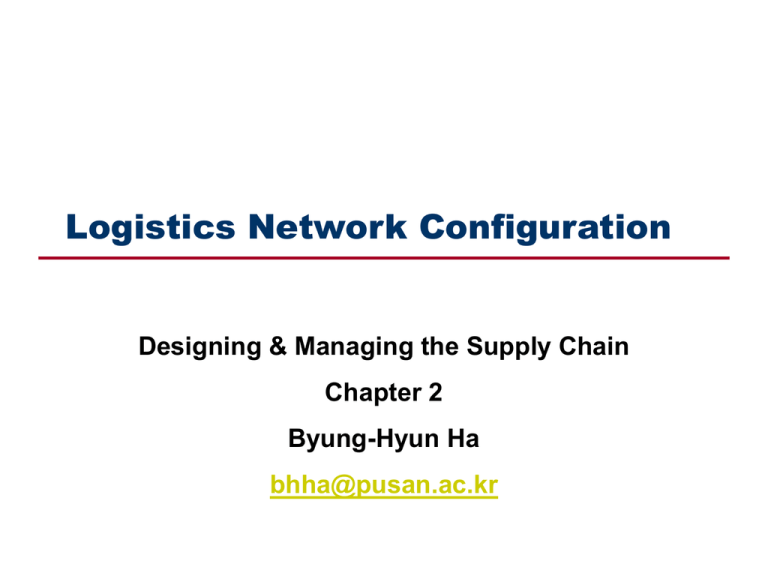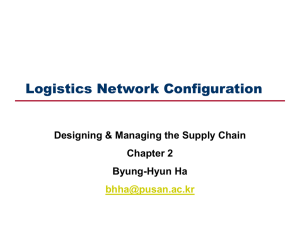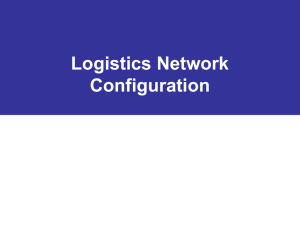08fl2
advertisement

Logistics Network Configuration
Designing & Managing the Supply Chain
Chapter 2
Byung-Hyun Ha
bhha@pusan.ac.kr
Outline
Case: Bis Corporation
What is Logistics Network Configuration?
Methodology
Data Collection
Modeling and Validation
Solution Techniques
Features of Network Configuration DSS
Summary
Case: Bis Corporation
Background
Produce & distribute soft drinks
2 manufacturing plant
120,000 account (retailers and stores), all over the US
3 existing warehouse (Chicago, Dallas, Sacramento)
20% gross margin
$1,000 for each SKU (stock-keeping unit) for all products
Current distribution strategy (designed 15 years ago)
Produce and store at the manufacturing plant
Pick, load, and ship to a warehouse/distribution center
Unload and store at the warehouse
Pick, load, and deliver to store
Case: Bis Corporation
You, consulting company
Proposal as reengineering the sales and distribution functions
First phase, identifying 10,000 direct delivery account, based on
•
•
•
•
•
•
•
•
Dock receiving capabilities
Storage capability
Receiving methodologies
Merchandising requirements
Order-generation capabilities
Delivery time window constraints
Current pricing
Promotional activity patterns
Case: Bis Corporation
Redesign distribution network
Grouped accounts into 250 zones, products into 5 families
Data collected
•
•
•
•
•
Demand in 1997 by SKU per product family for each zone
Annual production capacity at each manufacturing plant
Maximum capacity for each warehouse, new and existing
Transportation costs per product family per mile for distributing
Setup cost for establishing a warehouse
Customer service level requirement
No more than 48 hours in delivery
Additionally,
Estimated yearly growth, variable production cost, cost for
increasing production capacity, …
Case: Bis Corporation
Issues
How can Bis Corporation validate the model?
Impact of aggregating customers and products
Number of established distribution centers and their locations
Allocation of plant’s output between warehouses
When and where should production capacity be expanded?
Introduction
Issues of this chapter
Development of a model representing logistics network
Validation of the model
Aggregation of customers and products and accuracy of the
model
Number of distribution centers to be established
Location of distribution centers
Allocation of output of each product in plants among distribution
centers
Decision about whether, when, and where to expand production
capacity
Introduction
Components of logistics network
Facilities
• Suppliers, warehouse, distribution centers, retail outlets
Flows
• Raw material, work-in-process inventory, finished products
Sources:
plants
vendors
ports
Regional
Warehouses:
stocking
points
Field
Warehouses:
stocking
points
Customers,
demand
centers
sinks
Supply
Inventory &
warehousing
costs
Production/
purchase
costs
Transportation
costs
Inventory &
warehousing
costs
Transportation
costs
Network Design
Strategic level – decisions that typically involve
major capital investments and have a long term
effect
Number, location and size of new plants, distribution centers and
warehouses
Acquisition of new production equipment and the design of
working centers within each plant
Design of transportation facilities, communications equipment,
data processing means, …
Tactical level
Determine optimal sourcing strategy (strategic?)
• Which plant/vendor should produce which product
Determine best distribution channels (strategic?)
• Which warehouses should service which customers
Selection of transportation mode (e.g. rail, truck)
Network Design
Network design or reconfigure problem
Objective
• Minimize annual system-wide costs
Subject to
• Variety of service level requirements
The objective is to balance service level against
Production/purchasing costs
Inventory carrying costs
Facility costs (handling and fixed costs)
Transportation costs
Network Design
Tradeoffs
$90
$80
Cost (millions $)
$70
$60
Total Cost
Transportation Cost
Fixed Cost
Inventory Cost
$50
$40
$30
$20
$10
$-
0
2
4
6
Number of Warehouses
8
10
Network Design
Increasing number of warehouse typically yields
improvement in service level
increase in inventory cost
increase in overhead and setup cost
reduction in outbound transportation costs
increase in inbound transportation costs
Network Design
Industry benchmarks: average # of warehouses
Pharmaceuticals
3
- High margin product
- Service not important (or
easy to ship express)
- Inventory expensive
relative to transportation
Food Companies
14
Chemicals
25
- Low margin product
- Service very important
- Outbound transportation
expensive relative to inbound
Sources: CLM 1999, Herbert W. Davis & Co; LogicTools
Outline
Case: Bis Corporation
What is Logistics Network Configuration?
Methodology
Data Collection and Aggregation
Modeling and Validation
Solution Techniques
Features of Network Configuration DSS
Summary
Data Collection
Data for network design
Location of customers, stocking points and sources
A listing of all products (volumes, transportation modes)
Demand for each product by customer location
Transportation rates
Warehousing costs
Shipment sizes by product
Order patterns by frequency, size, season, content
Order processing costs
Customer service requirement and goals
Data Aggregation
Optimization model for the problem?
Typical soft drink distribution system: 10,000~20,000 accounts
Wal-Mart or JC Penney: hundreds of thousands!
Too much
Data aggregation
Customer aggregation
Product aggregation
Why?
Cost of obtaining and processing data
Form in which data is available
Size of the resulting location model
Accuracy of forecast demand
Data Aggregation: Customer
Customer aggregation
Aggregating customers located in close proximity
• Using a grid network or clustering techniques
All customers within a single zone
• Replaced by a single customer located at the centroid of the zone
Aggregation by classes
• Service levels, frequency of delivery, …
Customer zone balances
accuracy loss due to over aggregation needless complexity
Data Aggregation: Customer
Experimental results: cost difference < 0.05%
Considering transportation costs only
Customer data
• Original data had 18,000 ship-to locations
• Aggregated data had 800 ship-to locations
• Total demand was the same in both cases
Total Cost:$5,796,000 Total Customers: 18,000
Total Cost:$5,793,000 Total Customers: 800
Data Aggregation: Product
Product aggregation
Hundreds to thousands of individual items in production line
• Variations in product models and style
• Same products are packaged in many sizes
Collecting all data and analyzing it is impractical
Aggregation by distribution pattern
Place SKU’s into a source group
• A source group is a group of SKU’s all sourced from the same place
to the same customers
Aggregate SKU’s by similar logistics characteristics
• Weight, volume, holding cost, …
Aggregation by product type
Different products might simply be variations in product style or
differ only in type of packaging
Data Aggregation: Product
Aggregation by distribution pattern
70.0
60.0
Weight (lbs per case)
50.0
40.0
30.0
20.0
10.0
0.0
0.000
0.010
0.020
0.030
0.040
0.050
0.060
Volume (pallets per case)
0.070
0.080
0.090
0.100
Data Aggregation: Product
Test case for product aggregation
5 plants
25 potential warehouse locations
Distance-based service constraints
Inventory holding costs
Fixed warehouse costs
Product aggregation
• 46 original products
• 4 aggregated products
• Aggregated products were created using weighted averages
Data Aggregation: Product
Experimental results: cost difference < 0.05%
Total Cost:$104,564,000
Total Products: 46
Total Cost:$104,599,000
Total Products: 4
Data Aggregation
Recommended approach
Aggregate demand points for 150 to 200 zones
• e.g. if customers are classified into classes according to their
service levels or frequency of delivery, each class will have 150-200
aggregated points
Make sure each zone has an equal amount of total demand
• Zone may be different geographic size
Place the aggregated point at the center of the zone
Aggregate products into 20 to 50 product groups
In this case, the error is typically no more than 1%
Variability reduction
Even if technology exists to solve problem with original data,
forecast customer demand at account and product level is
usually poor
Impact of Aggregation on Variability
Measure of variability?
Standard deviation (SD)
• Enough?
X
Xi
n
SD2
2
(
X
X
)
i
n
Which one has bigger SD than the other?
30
400
15
200
0
0
Impact of Aggregation on Variability
Measure of variability
Coefficient of variation
CV
SD
X
CVA CVB
30
400
A
B
15
200
0
0
Impact of Aggregation on Variability
Historical data for the two customers
Year
1992
1993
1994
1995
1996
1997
1998
Customer 1
22,346
28,549
19,567
25,457
31,986
21,897
19,854
Customer 2
17,835
21,765
19,875
24,346
22,876
14,653
24,987
Total
40,181
50,314
39,442
49,803
54,862
36,550
44,841
Summary of historical data
Statistics
Average
annual demand
Standard deviation
annual demand
Coefficient
of variation
Customer 1
24,237
4,658
0.192
Customer 2
20,905
3,427
0.173
Total
45,142
6,757
0.150
Transportation Rates
Constructing effective distribution network model
We should consider reasonable transportation rates
Important characteristics of most rates
Rates are almost linear with distance but not with volume
Rates of internal fleet
Transportation cost for company-owned trucks
Calculation of cost per mile per SKU
• Annual costs per truck, annual mileage per truck, annual amount
delivered, truck’s effective capacity
Rate of external fleet
Distinguish between truckload (TL) and less than truckload (LTL)
Transportation Rates
TL carriers
Subdivision of country into zones
Zone-to-zone table for cost
Cost structure is not symmetric (why?)
• e.g. Shipping Illinois NY is more expensive than in reverse way
LTL industry
Types of freight rates
• Class rate (standard)
• Classification tariff based on density, ease of handling, liability
for damage
• Rate base number based on distance
• Exception rate
• Less expensive rate
• Commodity rate
Transportation Rates
Mileage estimation
Straight line distance Dab in US from a to b
• Let lonx and latx be longitude of x and latitude of x
Dab 69 (lona lonb ) 2 (lat a latb ) 2
For long distances by correcting for earth’s curvature
Dab 2(69) sin 1
2
lat latb
lon lonb
sin a
cos(lata ) cos(latb ) sin a
2
2
2
Warehouse Costs
Three main components
Handling costs
• Labor costs, utility costs
• Fairly can be estimated
Fixed costs
• Cost components that are not proportional to the amount of material
the flows through the warehouse
• Typically proportional to warehouse size (but not linear way)
Storage costs
Inventory turnover ratio =
annual sales
average inventory level
fixed cost
• Inventory holding cost that are proportional to average positive
inventory level
warehouse size
Warehouse Capacities
Capacity estimation
inventory
level
Calculating peak level by assuming regular shipment and
delivery – twice average inventory level
order
size
average
time
Space for access and handling
• For aisles, picking, sorting, processing facilities, AGVs, …
• Represented as a factor (>1)
Other Issues for Data Collection
Potential warehouse locations
Geographical and infrastructure conditions
Natural resources and labor availability
Local industry and tax regulations
Public interest
Service level requirements
e.g. 95% of customers be situated within 200 miles of the
warehouses serving them
Future demand
Network design is at strategic level and impacts on next 3~5
years
Using scenario-based approach incorporating net present value
Other Issues for Data Collection
Example of scenario-based approach
Determine demand and marketing cost of new product
Don’t market
nationally
.60
High local demand
.85
High demand
Market
nationally
.15
Low demand
Don’t market
nationally
Test market
.10
High demand
.40
Low local demand
Market
nationally
.55
High demand
Don’t test
market
Market
nationally
.45
Low demand
Don’t market
nationally
.90
Low demand
Outline
Case: Bis Corporation
What is Logistics Network Configuration?
Methodology
Data Collection and Aggregation
Modeling and Validation
Solution Techniques
Features of Network Configuration DSS
Summary
Model and Data Validation
Model?
Data validation
Ensuring data and model accurately reflect the network design
problem
Done by reconstructing the existing network configuration using
the model and collected data comparing the output of the
model to company’s accounting information
Can identify errors in the data, problematic assumptions,
modeling flaws, …
• e.g. transportation cost estimated by model consistently
underestimating actual cost become to find that effective truck
capacity was only about 30%
Thus, validation process not only help calibrate parameters but
also suggest potential improvement of existing network
Model and Data Validation
Sensitivity analysis
Make local and small changes in model, and estimate impact on
costs and service level
• Positing a variety of what-if question
• e.g. closing the existing warehouse, changing flow of materials
Can have good intuition about what the effect of small-scale
changes
Can identify errors in model
In summary, model validation process involves
answering the following questions:
Does the model make sense?
Are the data consistent?
Can the model results be fully explained?
Did you perform sensitivity analysis?
Solution Techniques
Techniques for optimizing configuration of logistics
network
Mathematical optimization techniques
• Exact algorithms: find optimal solutions
• Heuristics: find good solutions, not necessarily optimal
Simulation models
• provide a mechanism to evaluate specified design alternatives
created by the designer
Heuristics and Exact Algorithms
E.g. a distribution system
Single product
Two plants p1 and p2
Plant p2 has an annual capacity of 60,000 units
The two plants have the same production costs
There are two warehouses w1 and w2 with identical warehouse
handling costs.
There are three markets areas c1, c2 and c3 with demands of
50,000, 100,000 and 50,000, respectively
Distribution cost per unit
Facility
warehouse
p1
p2
c1
c2
c3
w1
0
4
3
4
5
w2
5
2
2
1
2
Heuristics and Exact Algorithms
A distribution system
$0
D = 50,000
$3
$4
$5
D = 100,000
$2
$4
Cap = 60,000
$5
$2
$1
$2
D = 50,000
Production costs are the same, warehousing costs are the same
Heuristics and Exact Algorithms
Heuristic 1
For each market, choose the cheapest warehouse to source
demand. Then, for every warehouse, choose the cheapest plant.
D = 50,000
$5 x 140,000
D = 100,000
$2 x 50,000
Cap = 60,000
$2 x 60,000
$1 x 100,000
$2 x 50,000
Total Costs = $1,120,000
D = 50,000
Heuristics and Exact Algorithms
Heuristic 2
For each market area, choose the warehouse such that the total
delivery costs to the warehouse and from the warehouse to the
market is the smallest. (i.e. consider inbound and outbound costs)
$0
D = 50,000
$3
P1 to WH1
P1 to WH2
P2 to WH1
P2 to WH 2
$4
$5
D = 100,000
$2
$4
Cap = 60,000
$5
$2
$3
$7
$7
$4
$1
$2
P1 to WH1
P1 to WH2
P2 to WH1
P2 to WH 2
$4
$6
$8
$3
D = 50,000
P1 to WH1
P1 to WH2
P2 to WH1
P2 to WH 2
$5
$7
$9
$4
Heuristics and Exact Algorithms
Heuristic 2
For each market area, choose the warehouse such that the total
delivery costs to the warehouse and from the warehouse to the
market is the smallest. (i.e. consider inbound and outbound costs)
$0 x 50,000
D = 50,000
$3 x 50,000
P1 to WH1
P1 to WH2
P2 to WH1
P2 to WH 2
$5 x 90,000
Cap = 60,000
$2 x 60,000
D = 100,000
$1 x 100,000
$2 x 50,000
Total Cost = $920,000
$3
$7
$7
$4
P1 to WH1
P1 to WH2
P2 to WH1
P2 to WH 2
$4
$6
$8
$3
D = 50,000
P1 to WH1
P1 to WH2
P2 to WH1
P2 to WH 2
$5
$7
$9
$4
Heuristics and Exact Algorithms
Exact algorithm (linear programming)
xij: the flow from i to j
min. 0 x p1w1 5 x p1w2 4 x p2 w1 2 x p2 w2
3xw1c1 4 xw1c2 5 xw1c3 2 xw2c1 xw2c2 2 xw2c3
s.t. x p2 w1 x p2 w2 60,000
x p1w1 x p2 w1 xw1c1 xw1c2 xw1c3
x p1w2 x p2 w2 xw2c1 xw2c2 xw2c3
xw1c1 xw2c1 50,000
xw1c2 xw2c2 100,000
xw1c3 xw2c3 50,000
xij 0 i, j
Total Cost = $740,000
Heuristics and Exact Algorithms
Network configuration problem is generally
formulated as integer programming
Hard to obtain the optimal solution
Some typical types of network design model
Uncapacitated facility location model
Capacitated facility location model
Network optimization model
Source: Camm et al. 1997
Heuristics and Exact Algorithms
Uncapacitated facility location model
Example
• Which DC will open and which customer zone will assign to which
DC?
• cij: total cost of satisfying customer zone j demand from DC i
• k: number of DCs allowed
• I: index set of DCs
min. cij xij
• J: index set of customer zones
iI jJ
• xij = 1 if customer zone j is
s.t. xij 1 j J
iI
assigned to DC i, 0 if not
xij yi i I , j J
• yi = 1 if DC i opens, 0 if not
yi k
iI
xij , yi {0, 1} i I , j J
Source: Camm et al. 1997
Heuristics and Exact Algorithms
Capacitated plant location model
Example: SunOil, a global energy company
• The world is divided into 5 different regions: N. America, S. America,
Europe, Asia, Africa
• SunOil has regional demand figures, transport costs, facility costs
and capacities
• We will ignore tariffs and exchange rate fluctuations for now, and
assume all demand must be met (so we can focus on minimizing
costs)
Question:
• Where to locate facilities to service their demand
• What size to build in the region (small or large), should they locate a
facility there
Source: Chopra and Meindl 2004
Heuristics and Exact Algorithms
Capacitated plant location model
n: number of potential plant location
• As we are considering two different type
plants (small, large) for each region, n = 10
m: number of markets
Dj: demand from market j
Ki: capacity of plant i
fi: fixed cost of keeping plant i open
cij: variable cost of sourcing market j
from plant i
yi = 1 if plant is located at site i,
= 0 otherwise
xij: quantity shipped from plant i to
market j
n
n
m
min f i yi cij xij
i 1
i 1 j 1
s.t.
n
x
i 1
ij
m
x
j 1
ij
Dj
K i yi
for j 1, , m
for i 1, , n
yi {0,1} for i 1, , n
Heuristics and Exact Algorithms
Network optimization model
Example: TelecomOne merged with High Optic
• They have plants in different cities and service several regions
• Supply cities
• Baltimore (capacity 18K), Cheyenne (24K), Salt Lake City (27K),
Memphis (22K) and Wichita (31K)
• Monthly regional demands
• Atlanta (demand 10K), Boston (6K), Chicago (14K), Denver
(6K), Omaha (7K)
• They will consider consolidating facilities
Source: Chopra and Meindl 2004
Heuristics and Exact Algorithms
Network optimization model
n: number of plant location
m: number of markets
Dj: demand from market j
Ki: capacity of plant i
cij: variable cost of sourcing
market j from plant i
xij: quantity shipped from plant i to
market j
n
m
min cij xij
i 1 j 1
s.t.
n
x
i 1
ij
m
x
j 1
ij
Dj
for j 1,, m
Ki
for i 1, , n
xij 0
Heuristics and Exact Algorithms
Assignment #3
Build an MIP model and solve it for the following problem using solver (either
CPLEX or LINDO). Submit the model, code, and solution in printed form.
DryIce Inc. is a manufacturer of air conditioners that has seen its demand grow
significantly. They anticipate nationwide demand for the year 2010 to be 180,000
units in the South, 120,000 units in the Midwest, 110,000 units in the East, and
100,000 units in the West. Mangers at DryIce are designing the manufacturing
network and have selected four potential sites – New York, Atlanta, Chicago, and
San Diego. Plants could have a capacity of either 200,000 or 400,000 units. The
annual fixed costs at the four locations are shown in the table below, along with
the cost of producing and shipping an air conditioner to each of the four markets.
Where should DryIce build its factories and how large should they be?
New York
Annual
fixed cost
Production &
transportation
cost
Atlanta
Chicago
San Diago
200,000 plant
$6 million
$5.5 million
$5.6 million
$6.1 million
400,000 plant
$10 million
$9.2 million
$9.3 million
$10.2 million
East
$211
$232
$238
$299
South
$232
$212
$230
$280
Midwest
$240
$230
$215
$270
West
$300
$280
$270
$225
Simulation Models
Limitation of mathematical optimization technique
Only dealing with static models – cost and demand do not
change over time
Simulation-based tools
Taking into account the dynamics of system
Being capable of characterizing system performance for a given
design
Simulation for micro-level analysis including
individual ordering pattern
specific inventory policy
inventory movement inside warehouses
Simulation Models
Limitation of simulation
Only evaluate costs associated with a pre-specified logistics
network design
That is, simulation is not an optimization tool
•
Some ways to use simulation for optimization
•
Not useful in determining an effective configuration from a large set
of potential configurations
Employing search technique of determining good parameter for
simulation model
Two-stage approach
1. Use optimization model to generate a number of least-cost
solution at macro-level
2. Use simulation model to evaluate solutions generated in the first
phase
Features of Network Configuration DSS
Flexibility
Ability of system to incorporate a large set of preexisting network
characteristics
One of key requirements of decision-support system (DSS) for
network design
Necessary to incorporate the following features
Customer-specific service level requirement
Existing warehouses (if lease have not expired, it cannot close)
Expansion of existing warehouses
Specific flow patterns should not be changed
Warehouse-to-warehouse flow
Bill of materials (BOM) (e.g. final assembly is done at a certain
warehouse)
Features of Network Configuration DSS
Robustness of DSS
Capability to deal with all issues with little or no reduction in its
effectiveness
That is, relative quality of the solution generated by DSS should
be independent of specific environment, variability of data, or
particular setting
Reasonable running time of DSS
Also have to be robust
Summary
Issues important in design of logistics network
Data collection, validation, solution techniques
Aggregation of data
Problem size
Forecast accuracy
Optimization-based decision-support system
Considers complex transportation cost structure, warehouse size,
manufacturing limitations, inventory turnover ratios, inventory
cost, service level
Can solve large-scale problem efficiently
Assignment #4
Discussion questions 3, 7 (pp. 41–42)









